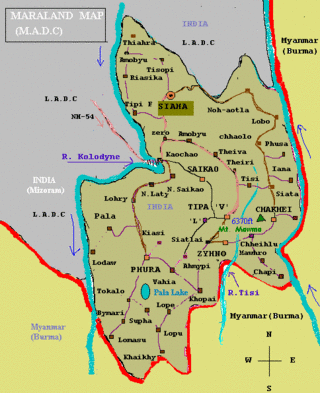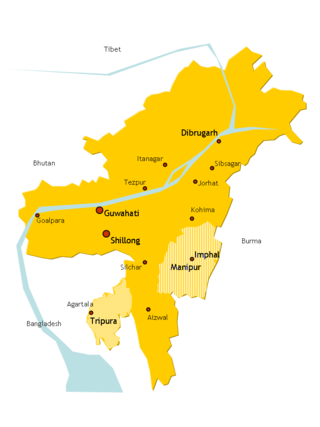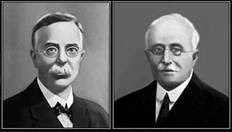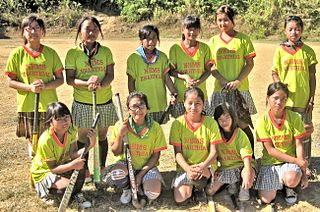Related Research Articles

Maraland is a region in the southeastern part of Mizoram state, India, referring not to a political or district name but specifically to the area inhabited by the Mara people. The region is one of the three Autonomous District Councils in the state. The Mara Autonomous District Council government is headed by Chief Executive Member, currently by Puhpa N. Zakhai, a veteran Congress politician.

Mara Autonomous District Council (MADC) is one of the three Autonomous District Councils within Mizoram state of India. It covers Siaha subdivision and Tipa subdivision of Siaha district. Primarily, an autonomous administrative government meant for the Mara people living in the state. It is situated at the southern tip of Mizoram state bordering Myanmar. Its autonomy was established and carved out from the erstwhile Pawi-Lakher Regional Council on 29 May 1971 and separated the next year as Lakher Autonomous District Council, and renamed to its current name in 1988. It covers 1445 square kilometres.

The Tripura Baptist Christian Union (TBCU) is a Baptist Christian denomination in Tripura, India. It has its head office in Agartala, the state capital. The TBCU is affiliated to the Asia Pacific Baptist Federation (APBF) and the Baptist World Alliance (BWA). It is also a member church in the North East India Christian Council (NEICC), a regional church body of the National Council of Churches in India (NCCI).

Baptist Church of Mizoram is a Baptist Christian denomination in India. It is affiliated with the Baptist World Alliance. The headquarters is in Lunglei, Mizoram.

The history of Mizoram encompasses the history of Mizoram which lies in the southernmost part of northeast India. It is a conglomerate history of several ethnic groups of Chin people who migrated from Chin State of Burma. But information of their patterns of westward migration are based on oral history and archaeological inferences, hence nothing definite can be said. The recorded history started relatively recently around the mid-19th century when the adjoining regions were occupied by the British monarchy. Following religious, political and cultural revolutions in the mid-20th century majority of the people agglomerated into a super tribe, Mizo. Hence the officially recognised settlement of the Mizos became Mizoram.

The World Communion of Reformed Churches (WCRC) is the largest association of Reformed (Calvinist) churches in the world. It has 230 member denominations in 108 countries, together claiming an estimated 80 million people, thus being the fourth-largest Christian communion in the world after the Catholic Church, Eastern Orthodox Church, and the Anglican Communion. This ecumenical Christian body was formed in June 2010 by the union of the World Alliance of Reformed Churches (WARC) and the Reformed Ecumenical Council (REC).
Protestants in India are a minority and a sub-section of Christians in India and also to a certain extent the Christians in Pakistan before the Partition of India, that adhere to some or all of the doctrines of Protestantism. Protestants in India are a small minority in a predominantly Hindu majority country, but form majorities in the north-eastern states of Meghalaya, Mizoram and Nagaland and significant minorities in Konkan division, Bengal, Kerala and Tamil Nadu, with various communities in east coast and northern states. Protestants today trace their heritage back to the Protestant reformation of the 16th century. There are an estimated 20 million Protestants and 16 million Pentecostals in India.
Evangelical Church of Maraland is a church in southern Mizoram in northeast India. It was founded by English missionary Reverend and Mrs Reginald Arthur Lorrain in 1907. It is the largest church among the Mara people. It is one of the three Mizoram churches pioneered by English missionaries in the 19th century; others are Mizoram Presbyterian Church and Baptist Church of Mizoram.
Mizoram Presbyterian ChurchSynod is the largest Christian denomination in Mizoram, northeast India. It was a direct progeny of the Calvinistic Methodist Church in Wales. It was the first church in Mizoram and is now one of the constituent bodies of a larger denomination Presbyterian Church of India (PCI), which has its headquarters in Shillong, Meghalaya. The administrative body called the Mizoram Synod has its headquarters at Mission Veng, Aizawl. As the first church, it remains the largest denomination in Mizoram.
The Presbyterian Church of India (PCI) is a mainline Protestant church based in India, with over one and a half million adherents, mostly in Northeast India. It is one of the largest Christian denominations in that region.
The Lai people mainly inhabit the southern parts of Chin Hills in Myanmar's Chin State, in the townships of Falam, Thantlang and Hakha. They are also found in the Lawngtlai district of Mizoram, India, where they have been granted the Lai Autonomous District Council. Outside this area they are scattered in Mizoram and in Manipur. Their languages "Laizo Lai" and "Hakha Lai" are classified as Central Kuki-Chin languages.
Mara Evangelical Church, or MEC in short, is one of the churches in Myanmar, formerly Burma, founded by English missionaries Reverend and Mrs. Reginald Arthur Lorrain in the year 1907. It is one of the oldest churches in Chin state, Myanmar. It was part of the unified Mara Church among the Mara people until it had to become independent after India and Myanmar attained independence from the British Raj in 1947. The Mara Church in India became the Evangelical Church of Maraland and Congregational Church of India, Maraland (CCI-M), while the one in Myanmar became MEC.

James Herbert Lorrain, or Pu Buanga, was a Scottish Baptist missionary in northeast India, including Mizoram, Assam, and Arunachal Pradesh. He and Frederick William Savidge reduced the Lushai language to writing—devised an alphabet using Roman lettering and phonetic form of spelling based on Hunterian system translation; compiled grammar and dictionaries for missionary activities and clerical administration.

Education in Mizoram consists of a diverse array of formal education systems ranging from elementary to university, from training institution to technical courses. The Government of India imposes mandatory education at least up to the basic level. For this public schools are made free of fees, and provided with free textbooks and school lunch.

Christianity is the largest religion in Mizoram. The majority 87% of Mizoram population are Christian in various denominations, predominantly Presbyterian. More than 98% of the Mizos are Christians by faith. The Government of Mizoram declared that Christianity plays a very important role among the daily life of Mizo community and therefore further declared that Christianity as the religion of the state. The culture of Mizoram is mainly influenced by Christianity. Hence, Christianity was given a special status on the state by the government while maintaining a minimum level of secular environment & approach. In June 2018, the government of Mizoram including Vanlalruata, president of anti-corruption organisation-turned-political party, People's Representation for Identity and Status of Mizoram claim that Mizoram is a Christian state. Hindus form a small minority (3.55%) mainly of Manipuris and there are also around (7.93%) Buddhists according to the 2001 census, mostly made up from Chakma settlers of Arakan origin. There are about 8,000 mostly ethnic Mizo followers of a Judaic group Bnei Menashe, who claim descent from the biblical Menasseh. Muslims make up about 1.1% of the state population.
North East India Christian Council (NEICC) is a Protestant ecumenical council of North East India, affiliated to the National Council of Churches in India as one of the regional councils in the year 1939.

Frederick William Savidge was a pioneer English Christian missionary in northeast India. He and James Herbert Lorrain brought Protestantism to Mizoram, and some parts of Assam and Arunachal Pradesh. Together they were entirely responsible for the creation of written language in Mizo, beginning of literacy, origin of formal education and establishment of churches in Mizoram. They devised the original Mizo alphabets based on Roman script, prepared the first book and dictionary in Mizo, started the first school among the Mizos. Mizoram has become the most Christian populated state in India. As a professional educator Savidge was single-handedly responsible for introducing quality education in Mizoram. He is deservedly known as the Father of Mizo Education.

The history of Christianity in Mizoram covers the origin and development of all forms of Christianity in Mizoram since the British occupation at the end of the 19th century. Christianity arrived as a consequence of tribal warfare, raids of British plantations, and the ensuing punitive British military expedition called the Lushai Expedition of 1871. The subsequent annexation of the erstwhile Lushai Hills to the British Empire opened the gateway for British Christian missions to evangelise the Mizo people.
References
- ↑ "Congregational Church of India (Maraland) Headquarters, Saikao ta Puhpa H. Malvina, CEM, MADC alykheina hnei". madc.mizoram.gov.in. Retrieved 2023-11-18.
- ↑ Hlychho, Ezra (2020). Mara Church History (in Marathi) (First ed.). Siaha, Mizoram.
{{cite book}}: CS1 maint: location missing publisher (link) - ↑ Bhatia, Lakshmi (2012-12-06). Education and Society in a Changing Mizoram: The Practice of Pedagogy. Routledge. ISBN 978-1-136-19805-2.
- ↑ RA, R.A. Five years unknown jungle.
- ↑ "CONGREGATIONAL CHURCH OF INDIA MARALAND SERKAWR GROUP Vs. CONGREGATIONAL CHURCH OF INDIA MARALAND SAIHA GROUP". www.the-laws.com. Retrieved 2023-11-18.
- ↑ "Maraland Report 2013 - Congregational Federation". studylib.net. Retrieved 2023-11-18.
- ↑ "Pageviews Analysis". pageviews.wmcloud.org. Retrieved 2023-11-18.
- ↑ Gooptu, Sarvani; Pandit, Mimasha (2023-07-24). Performance and the Culture of Nationalism: Tracing Rhizomatic Lived Experiences of South, Central and Southeast Asia. Taylor & Francis. ISBN 978-1-000-90125-2.
- ↑ "CONGREGATIONAL CHURCH OF INDIA MARALAND SERKAWR GROUP Vs. CONGREGATIONAL CHURCH OF INDIA MARALAND SAIHA GROUP". www.the-laws.com. Retrieved 2023-11-15.
- ↑ "CONGREGATIONAL CHURCH OF INDIA MARALAND SERKAWR GROUP Vs. CONGREGATIONAL CHURCH OF INDIA MARALAND SAIHA GROUP". www.the-laws.com. Retrieved 2023-11-18.
- ↑ "Address data base of Reformed churches and institutions". www.reformiert-online.net. Retrieved 2023-11-15.